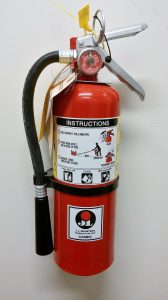Even though, this is the outdoor season we are still in our home about 50-60 percent of the day. With that being said it is no wonder that the home can be the most hazardous place to be. Here are 5 things that you can do today that will make your home a little bit safer.
Smoke Alarms –  It is important that there is a smoke alarm on every floor. There should be one in every bedroom and in the hallway adjoining them. Having a smoke alarm in the service room where the heating system can be an early warning device should there be an issue. Change the batteries in all smoke alarms twice a year. Try to pick an anniversary or holiday so that it is easier to remember when the batteries were changed. It is also important that you test your alarms once a month.
It is important that there is a smoke alarm on every floor. There should be one in every bedroom and in the hallway adjoining them. Having a smoke alarm in the service room where the heating system can be an early warning device should there be an issue. Change the batteries in all smoke alarms twice a year. Try to pick an anniversary or holiday so that it is easier to remember when the batteries were changed. It is also important that you test your alarms once a month.
Fire Extinguishers –  Put a fire extinguisher on every floor, specifically in the kitchen, garage, and utility room. Another good spot is in the linen closet outside of bedrooms and baths. Check the pressure gauge monthly to ensure that it is still pressurized. It is important that everyone in the home knows how to use an extinguisher. If you have an aging unit that is not completely depressurized, take the opportunity to replace it and use it to go over instructions on operation.
Put a fire extinguisher on every floor, specifically in the kitchen, garage, and utility room. Another good spot is in the linen closet outside of bedrooms and baths. Check the pressure gauge monthly to ensure that it is still pressurized. It is important that everyone in the home knows how to use an extinguisher. If you have an aging unit that is not completely depressurized, take the opportunity to replace it and use it to go over instructions on operation.
Bathroom mats –  On average, there are approximately 43,600 cases per year of bathroom related injuries for children under 18 years of age. Approximately, 81% of those injuries are attributed to slip, trip or falls. It is important that you have non-skid mats outside of the tubs and showers. Small children and the elderly are the most prone to slip injuries. It is some time helpful to add grab bars in or outside of the shower enclosure. (Additional Information:
On average, there are approximately 43,600 cases per year of bathroom related injuries for children under 18 years of age. Approximately, 81% of those injuries are attributed to slip, trip or falls. It is important that you have non-skid mats outside of the tubs and showers. Small children and the elderly are the most prone to slip injuries. It is some time helpful to add grab bars in or outside of the shower enclosure. (Additional Information:
Injuries Associated With Bathtubs and Showers)
GFCI (Ground Fault Circuit interrupter) outlets –  Ground fault interrupters are common now in all newer homes, but it if you are in an older home they may not be installed in all moisture prone areas. We at Pondview Inspections recommend that GFCI outlets be installed in the kitchen, bathrooms, garage, basement, wet bars and in exterior outlets or any place where there is the potential of water and electricity to come into contact. This safety device can save you life and cost around $13. They are not difficult to install. (How to install a GFCI outlet)
Ground fault interrupters are common now in all newer homes, but it if you are in an older home they may not be installed in all moisture prone areas. We at Pondview Inspections recommend that GFCI outlets be installed in the kitchen, bathrooms, garage, basement, wet bars and in exterior outlets or any place where there is the potential of water and electricity to come into contact. This safety device can save you life and cost around $13. They are not difficult to install. (How to install a GFCI outlet)
CFL or LED bulbs in closets –  Incandescent light bulbs can generate a lot of heat. The fixture needs to be enclosed to and should be 12 inches from combustibles. Recessed incandescent lights can be a minimum of 6 inches if they are completely enclosed. Compact florescent lights and newer Led type light bulbs generate less heat and will reduce chance of accidental fire when that blanket gets thrown on the top shelf. It is still recommend that combustible are not in direct contact with light fixtures. (2015 IRC codes related to Luminaries-lights)
Incandescent light bulbs can generate a lot of heat. The fixture needs to be enclosed to and should be 12 inches from combustibles. Recessed incandescent lights can be a minimum of 6 inches if they are completely enclosed. Compact florescent lights and newer Led type light bulbs generate less heat and will reduce chance of accidental fire when that blanket gets thrown on the top shelf. It is still recommend that combustible are not in direct contact with light fixtures. (2015 IRC codes related to Luminaries-lights)
Taking these quick and relatively inexpensive steps can help to make your home a little bit safer.

